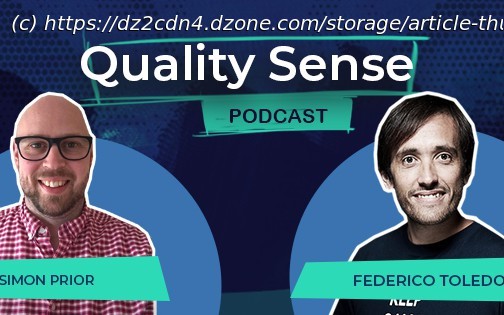In this Quality Sense podcast episode, hear from a professional who has worked across the cybersecurity, retail, gaming, and airline industries.
Join the DZone community and get the full member experience. In this Quality Sense episode, our host Federico has the pleasure of interviewing Simon Prior, who has worked across the cyber security, Retail, gaming and airline industries. Simon is a passionate software quality leader, advocate of the importance of teaching testing at universities and co-host of the Testing Peers podcast. Relevant Links: Quality Sense, a Software Testing Podcast · S3E9 – Simon Prior – #MakeATester Hello, Simon. How are you doing today? I’m good, thank you. How are you? I’m fine. Really, really happy that yesterday I got my first shot. Excellent. I think it’s like seeing the light at the end of the tunnel, right? Yeah, everyone in my family has got it apart from me so I’m still waiting for my first one. Okay but it’s going to come for everyone, I hope. Fingers crossed. Thank you for accepting the invitation. I’m really excited about talking to another podcast host! Tell us about Testing Peers please. Testing Peers is a podcast on testing and leadership. There’s four of us that co-host it. There’s myself, Chris Armstrong, Russell Craxford and David Maynard. And it started about three, four years ago. Chris reached out to a whole load of people who were in a situation where they may be the only tester in their company or the only person that seemed to care about quality or had no one to hold them to account on testing related issues. And we came together, it started off as a WhatsApp group and then it became a Slack channel. And we started talking about doing a blog, a collaborative blog where we all interacted and did these blog posts and then I came up with the idea, why don’t we just do a podcast? And it took a bit of convincing. We started the channel in about June, 2019. We started the Slack channel and talked about doing a podcast and then in May, 2020 we released the first episode. You can see there’s about nine months where I’m like, “Come on, we can do this. It would be worth doing.” And they were starting to get on board and we started designing logos and talking about topics and we now have a Trello board with about 50 or so plus topics to get through. We have a patron, we’re on… Got a sponsor. We’re trying to take over the world in testing and leadership. And it’s an enjoyment as well. Wednesday nights we sit down all of us with a beer or two and we record from our homes over Zoom for a couple of hours and it’s a social thing as much as I can be asked. Yeah, it’s good fun. It’s a social thing and your learning and enjoying a good conversation with friends. Absolutely. Sounds amazing. It’s good fun. Tell us also, what are you doing nowadays and how did you end up working in software testing? Yeah so I started my journey, I left university in 2007. I was a researcher on a cybersecurity cybercrime project to start with. Research on how we could profile criminals between different stuff online. And then I moved into cybersecurity. I worked for McAfee for 12 years. I started as a developer, a graduate developer, but I worked on a team where every other developer had 10 to 15 years experience. And there was me as a complete newbie, which was great to learn but it also meant I was the one that gets stuck in the build room, figuring the build scripts and I’m… Or working on Unix build scripts rather than getting to develop the code of the software because they were the experienced ones. They knew how to do the development. I get the little bug fixes here and there, but I never really got the full meaty development activity. I started picking up more of the testing tasks in the sprints. And as I learned to find more testing tasks, I learned I enjoy testing a lot more and started picking up right in the automation scripts in Perl or developing the new features, the testing for the new features. And eventually in 2010, I switched over to QA, started as a QA engineer. Worked across several different teams in McAfee, became a QA lead, eventually into QA management. And then I’ve moved on a couple of roles since where I’ve taken more senior QA roles on and I’m now a senior test manager at EasyJet. It’s taken its time, but I now sort of look after all the digital testing at EasyJet and that’s my main focus. Cool. Back in 2016 you initiated a movement or a thing called “make a tester.” Yes. What is it about? That started because I got asked to do a careers talk at the university I went to and they were interested and because they knew I worked in the software industry. They wanted me to come back and do a careers talk and as soon as they did, they then dived into, “What is it you actually do is in the software industry.” And I said, “I’m in software QA. I can come and talk about QA.” And they were like, “Oh! Oh! Not sure about that. That’s not really something we cover on our syllabus. Would you like to come and do a special interest talk instead?” And I was like, “That’s not really what I was putting out.” I was like, “We need more people in testing. I was happy to come and do a career talk.” I backed out of doing the careers talk and then I started researching the universities. “ I researched all the 25 top universities in the UK, spoke to their head of departments, researched their syllabuses and out of the whole top 25 universities, only one university had a module on software testing and software quality. “ And the rest- Let me guess, it was optional, right? Exactly. It was the second or third year module, it was optional. It wasn’t a core module at all. This was per the ends I then reached out to find out more and there were some modules… Some of them had modules where they did software engineering and they taught unit testing as part of the software engineering life cycle. But there was very little about testing as a whole. Then I was like, “Well, that explains why when we go to career fairs and try and hire graduates that no one knows what testing is.” Then why do you think people fall into testing later on? Because they don’t get it as an option to start with so they have to… The only way they get into testing is by falling into it. That then led me to going to the community and saying okay. Universities aren’t helping us with training for testers. How do we therefore get people interested in testing roles? What skills should we look for when hiring a tester? Or what skills should they develop? And I created the #MakeATester. I started a meetup, the meetup that I run. I ran a white boarding session at that point about what skills can we look for in testers? And I created this list, I’d had 400 responses then 26,28,30 top skills and four of the five top skills were soft skills. There was communication, there was listening, there was, trying to think questioning, good curiosity and question asking and technical skills were right down the list. And then it was like, well, that’s probably why it’s not a natural fit for university courses because it’s not teaching the technical skills. It’s more about the critical thinking, the analytical skills. Then how do we build out a course for that? And that’s the point I got to where I presented a talk at UKSTAR, the conference and I got quite a lot of feedback from the community and other people started going out and now I’m at the point where we’re trying to spread the word and try and bring that word out further and trying to either get more universities to pick it up or to try and find other ways in which we can get that interest in the testing industry. In Uruguay, I was collaborating as a teacher for a subject in software testing. But as I say, that’s why I asked if it was optional because in this case, it was at the end of the career and it was an optional subject. I think for people working as developers today, we are forming them, giving this idea that testing is something that you do at the end and as an option, I think.






